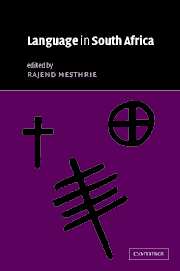Book contents
- Frontmatter
- Contents
- List of maps
- List of contributors
- Acknowledgements
- List of phonetic symbols
- List of abbreviations
- Introduction
- Part I The main language groupings
- Part II Language contact
- 9 Fanakalo: a pidgin in South Africa
- 10 Mutual lexical borrowings among some languages of southern Africa: Xhosa, Afrikaans and English
- 11 Code-switching, mixing and convergence in Cape Town
- 12 Code-switching in South African townships
- 13 Intercultural miscommunication in South Africa
- 14 Women's language of respect: isihlonipho sabafazi
- 15 The sociohistory of clicks in Southern Bantu
- 16 The political economy of language shift: language and gendered ethnicity in a Thonga community
- 17 From second language to first language: Indian South African English
- 18 Black South African English
- 19 The lexicon and sociolinguistic codes of the working-class Afrikaans-speaking Cape Peninsula coloured community
- 20 An Introduction to Flaaitaal (or Tsotsitaal)
- 21 Language and language practices in Soweto
- Part III Language planning, policy and education
- Index
- References
20 - An Introduction to Flaaitaal (or Tsotsitaal)
from Part II - Language contact
Published online by Cambridge University Press: 22 September 2009
- Frontmatter
- Contents
- List of maps
- List of contributors
- Acknowledgements
- List of phonetic symbols
- List of abbreviations
- Introduction
- Part I The main language groupings
- Part II Language contact
- 9 Fanakalo: a pidgin in South Africa
- 10 Mutual lexical borrowings among some languages of southern Africa: Xhosa, Afrikaans and English
- 11 Code-switching, mixing and convergence in Cape Town
- 12 Code-switching in South African townships
- 13 Intercultural miscommunication in South Africa
- 14 Women's language of respect: isihlonipho sabafazi
- 15 The sociohistory of clicks in Southern Bantu
- 16 The political economy of language shift: language and gendered ethnicity in a Thonga community
- 17 From second language to first language: Indian South African English
- 18 Black South African English
- 19 The lexicon and sociolinguistic codes of the working-class Afrikaans-speaking Cape Peninsula coloured community
- 20 An Introduction to Flaaitaal (or Tsotsitaal)
- 21 Language and language practices in Soweto
- Part III Language planning, policy and education
- Index
- References
Summary
INTRODUCTION AND HISTORY
Flaaitaal, or Tsotsitaal, is a South African township argot which is used mainly, but not exclusively, by black males in various urban centres. It is a mixed code in so far as it seems to have been initially reliant on Afrikaans for structure and a variety of languages for its lexis. To the uninitiated ear, Flaaitaal might sound like a variety of Afrikaans; but such a conclusion would overlook its robust Bantu language texture. Although ‘Tsotsitaal’ is a well-known term, in this chapter I will use the term ‘Flaaitaal’, which is a more commonly used name.
THE ORIGINS OF FLAAITAAL
Flaaitaal probably owes its origins to language contact within a multilingual setting in nineteenth-century South Africa and to the rise of the urban and township communities. In the latter half of the nineteenth century with the discovery of minerals in the South African interior people from all over the world, as well as from parts of South Africa, flocked to these diggings: Europeans speaking English, French, German, Dutch or Yiddish and Africans speaking Zulu, Xhosa, Sotho and Tswana, to name a few. Although this era preceded the evolution of Flaaitaal, it might well have sparked the initial yet crude substratum for its later emergence. An example of informal Afrikaans used by Bantu-language speakers is mentioned by M. S. Evans in a 1916 publication cited by Reinecke et al. (1975).
- Type
- Chapter
- Information
- Language in South Africa , pp. 398 - 406Publisher: Cambridge University PressPrint publication year: 2002
References
- 15
- Cited by

